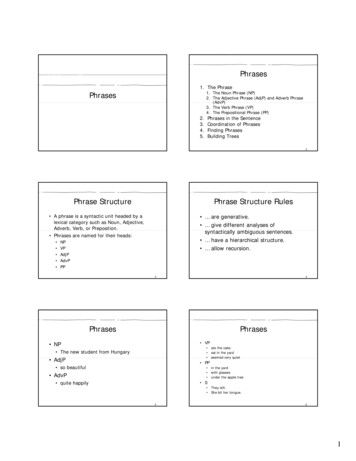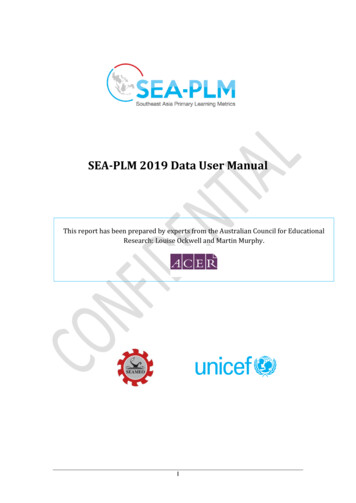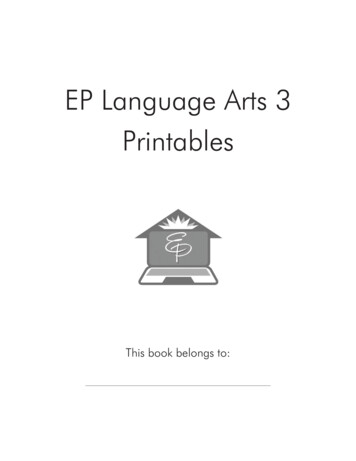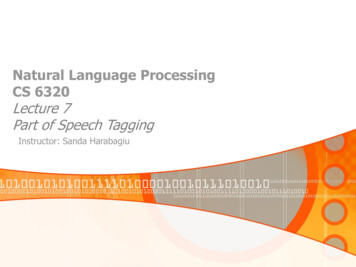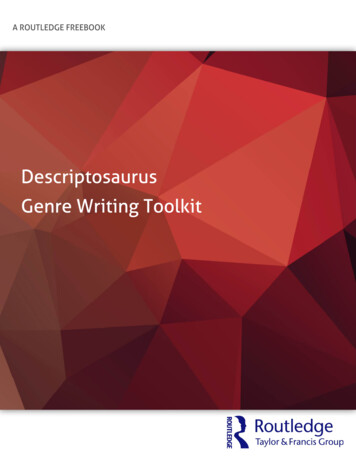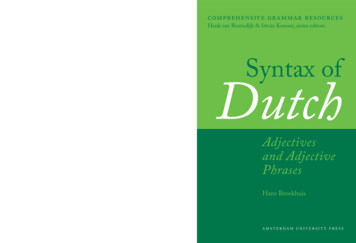
Transcription
The Syntax of Dutch will be published in at least seven volumes in theperiod 2012-2016 and aims at presenting a synthesis of the currentlyavailable syntactic knowledge of Dutch. It is primarily concernedwith language description and not with linguistic theory, and providessupport to all researchers interested in matters relating to the syntax ofDutch, including advanced students of language and linguistics.project manages to harmonize demands of depth and breadth. In partthis appears to be due to the highly systematic approach followed. Ibelieve the Syntax of Dutch project will ultimately become a model forcomprehensive grammatical description in the years ahead.Richard Larson, Professor of Linguistics at University of Stony Brook”Adjectives andAdjective PhrasesThis project is, by all measures, an extraordinary one, both in“conceptionand execution. To a remarkable degree the Syntax of DutchSyntax ofHans Broekhuis is a researcher at the Meertens Institute inAmsterdam.DutchThe volume Adjectives and Adjective Phrases discusses the internalmake-up as well as the distribution of adjective phrases. Topicsthat will be covered include: complementation and modificationof adjective phrases; comparative and superlative formation; theattributive, predicative and adverbial uses of adjective phrases. Specialattention is paid to the so-called partitive genitive construction andthe adverbial use of past/passive participles and Comprehensive Grammar ResourcesHenk van Riemsdijk & István Kenesei, series editorsSyntax ofDutchAdjectivesand AdjectivePhrasesHans Broekhuisisbn 978 90 8964 549 4amsterdam university presswww.aup.nlA m s t e r d a m U n i v e rsi t y P r e ss
Syntax of DutchAdjectives and Adjective Phrases
Comprehensive Grammar ResourcesEditors:Henk van RiemsdijkIstván Kenesei
Syntax of DutchAdjectives and Adjective PhrasesHans BroekhuisWith the cooperation of:Hans BennisCarole BosterMarcel den DikkenMartin EveraertLiliane HaegemanEvelien KeizerAnneke NeijtHenk van RiemsdijkGeorges de SchutterRiet VosAmsterdam University Press
The publication of this book is made possible by grants and financial support from:Netherlands Organisation for Scientific Research (NWO)Center for Language StudiesUniversity of TilburgTruus und Gerrit van Riemsdijk-Stiftung.Meertens Institute (KNAW)This book is published in print and online through the online OAPEN library(www.oapen.org)OAPEN (Open Access Publishing in European Networks) is a collaborativeinitiative to develop and implement a sustainable Open Access publication modelfor academic books in the Humanities and Social Sciences. The OAPEN Libraryaims to improve the visibility and usability of high quality academic research byaggregating peer reviewed Open Access publications from across Europe.Cover design: Studio Jan de Boer, AmsterdamLayout: Hans BroekhuisISBN978 90 8964 549 4e-ISBN 978 90 4851 932 3 (pdf)e-ISBN 978 90 4851 933 0 (ePub)\NUR616 / 624Creative Commons License CC BY ans Broekhuis/Amsterdam University Press, Amsterdam 2013Some rights reserved. Without limiting the rights under copyright reserved above,any part of this book may be reproduced, stored in or introduced into a retrievalsystem, or transmitted, in any form or by any means (electronic, mechanical,photocopying, recording or otherwise).
ContentsAbbreviations and symbolsixPreface and acknowledgmentsxi1. General introduction2. Main objective3. Intended readership4. Object of description5. Organization of the material6. History of the project and future prospects7. apter 1Adjectives: characteristics and classification31.1.1.2.1.3.1.4.Syntactic usesInflectionA semantic classificationBibliographical notesChapter 2Projection of adjective phrases I: Complementation2.1.2.2.2.3.2.4.2.5.Prepositional complementsNominal complementsDiscontinuous adjective phrasesPronominalization of the adjective (phrase)Bibliographical notes51113646566758498100Chapter 3Projection of adjective phrases II: 8192201Modification of scalar adjectivesModification of absolute adjectivesNegative and affirmative contextsPronominalization of the adjectiveSpecial casesBibliographical notes
Chapter 4Projection of adjective phrases III: uative, comparative and superlative formationSyntactic uses of equatives, comparatives and superlativesComparison and degree modificationPronominalization of the adjectiveBibliographical notesChapter 5Attributive use of the adjective 2InflectionAttributively used adjectives versus other prenominal elementsAttributively used complex adjective phrasesN-ellipsisCo-occurring adjectivesBibliographical notesChapter 6Predicative use of the adjective 377387411416417Logical SUBJECTsComplementive use of the adjectiveSupplementive use of the adjectiveAppositive use of the adjectiveClausal SUBJECTSPP SUBJECTSAP SUBJECTSBibliographical notesChapter 7The partitive genitive The structure of the partitive genitive constructionThe partitive genitive construction and its constituentsModification of the adjectival partSpecial cases: Iets anders/dergelijks ‘something else/similar’Bibliographical notesChapter 8Adverbial use of the adjective phrase4638.1.8.2.8.3.8.4.8.5.464467485486491The categorial status of adverbsModification in the clausal domain: clause and VP adverbsModification of adjectival phrasesModification of adpositional phrasesModification of the noun (phrase)
Chapter 9Participles and infinitives: their adjectival 51554General discussionAttributive usePredicative useThe partitive genitive constructionAdverbial useModification of (pseudo-)participles and deverbal adjectivesBibliographical notesChapter 10Special Constructions55710.1.10.2.558564Verb Adjective collocationsIn het adjective: In het algemeen ‘In general’Glossary567Subject index587References601
Abbreviations and symbolsThis appendix contains a list of abbreviations and symbols that are used in thisvolume. Sometimes conventions are adopted that differ from the ones given in thislist, but if this is the case this is always explicitly mentioned in the text. xxxRefers to the XXX in the glossaryDomain DDomain of discourseN section # N3.2 refers to Section 3.2. in Hans Broekhuis & Evelien Keizer(2012) and Hans Broekhuis & Marcel den Dikken (2012), Grammarof Dutch: nouns and noun phrases, Vol. 1 & 2.P section # P3.2 refers to Section 3.2. in Hans Broekhuis (to appear). Grammarof Dutch: Adpositions and adpositional phrases.QCQuantificational binominal constructionV section # V3.2 refers to Section 3.2. in Hans Broekhuis & Norbert Corver (inprep). Grammar of Dutch: Verbs and verb phrases.Abbreviations used in both the main text and the examplesAPAdjectival PhrasePPPrepositional PhraseDPDeterminer PhraseQPQuantifier PhraseNPNoun Phrase*VPVerb PhraseNumPNumeral Phrase*) Noun phrase is written in full when the NP-DP distinction is not relevant.Symbols, abbreviations and conventions used in the examplesePhonetically empty elementRefReferent argument (external thematic role of nouns/adjectives)RelRelated argument (internal thematic role of relational nouns)OPEmpty operatorPGParasitic gapPROImplied subject in, e.g., infinitival clausesImplied subject PRO with arbitrary (generic) referencePROarbtTrace (the original position of a moved element)XXXSmall caps indicates that XXX is assigned contrastive accentAbbreviations used as subscripts in the examplesnomnominative1p/2p/3p1st, 2nd, 3rd scmasculinesgsingular
xAbbreviations used in the glosses of the examplesAFFAffirmative markerCOMPComplementizer: dat ‘that’ in finite declarative clauses, of‘whether/if’ in finite interrogative clauses, and om in infinitivalclausesprt.Particle that combines with a particle verbPRTParticle of different kindsREFLThe short form of the reflexive pronoun, e.g., zich; the long formzichzelf is usually translated as himself/herself/itselfXXXSmall caps in other cases indicates that XXX cannot be translatedDiacritics used for indicating acceptability judgments*Unacceptable*?Relatively acceptable compared to *?Intermediate or unclear status?Marked: not completely acceptable or disfavored form(?)Slightly marked, but probably acceptableno marking Fully acceptable%Not (fully) acceptable due to non-syntactic factors or varyingjudgments among speakers#Unacceptable under intended reading Special status: old-fashioned, archaic, very formal, incoherent, etc.Other conventionsxx/yyAcceptable both with xx and with yy*xx/yyUnacceptable with xx, but acceptable with yyxx/*yyAcceptable with xx, but unacceptable with yy(xx)Acceptable both with and without xx*(xx)Acceptable with, but unacceptable without xx(*xx)Acceptable without, but unacceptable with xx. xx Alternative placement of xx in an example. *xx .Impossible placement of xx in an example Necessarily implies Does not necessarily imply/XX . YYItalics indicate bindingXXi . YYi Coindexing indicates coreferenceXXi . YYj Counter-indexing indicates disjoint referenceUnacceptable with index i, acceptable with index jXX*i/jUnacceptable with index j, acceptable with index iXXi/*jConstituent brackets of a constituent XP[XP . ]
Preface and acknowledgments1. General introductionDutch is an official language in the Netherlands, Belgium-Flanders, Surinam,Aruba and the Netherlands Antilles. With about 22 million native speakers it is oneof the world's greater languages. It is taught and studied at about 250 universitiesaround the world -people.html). Furthermore, Dutch is one ofthe most well-studied living languages; research on it has had a major, and stillcontinuing, impact on the development of formal linguistic theory, and it plays animportant role in various other types of linguistic research. It is therefore unfortunate that there is no recent comprehensive scientifically based description of thegrammar of Dutch that is accessible to a wider international audience. As a result,much information remains hidden in scientific publications: some information isembedded in theoretical discussions that are mainly of interest for and accessible tocertain groups of formal linguists or that are more or less outdated in the light ofmore recent findings and theoretical developments, some is buried in publicationswith only a limited distribution, and some is simply inaccessible to large groups ofreaders given that it is written in Dutch. The series Syntax of Dutch (SoD) aims atfilling this gap for syntax.2. Main objectiveThe main objective of SoD is to present a synthesis of currently available syntacticknowledge of Dutch. It gives a comprehensive overview of the relevant research onDutch that not only presents the findings of earlier approaches to the language, butalso includes the results of the formal linguistic research carried out over the lastfour or five decades that often cannot be found in the existing reference books. Itmust be emphasized, however, that SoD is primarily concerned with languagedescription and not with linguistic theory; the reader will generally look in vain forcritical assessments of theoretical proposals made to account for specificphenomena. Although SoD addresses many of the central issues of current linguistictheory, it does not provide an introduction to current linguistic theory. Readersinterested in such an introduction are referred to one of the many existingintroductory textbooks, or to handbooks like The Blackwell Companion to Syntax,edited by Martin Everaert & Henk van Riemsdijk, or The Cambridge Handbook ofGenerative Syntax, edited by Marcel den Dikken. A recent publication that aims atproviding a description of Dutch in a more theoretical setting is The Syntax ofDutch by Jan-Wouter Zwart in the Cambridge Syntax Guides series.3. Intended readershipSoD is not intended for a specific group of linguists, but aims at a more generalreadership. Our intention was to produce a work of reference that is accessible to alarge audience that has some training in linguistics and/or neighboring disciplinesand that provides support to all researchers interested in matters relating to the
xii Syntax of Dutch: nouns and noun phrasessyntax of Dutch. Although we did not originally target this group, we believe thatthe descriptions we provide are normally also accessible to advanced students oflanguage and linguistics. The specification of our target group above implies thatwe have tried to avoid jargon from specific theoretical frameworks and to use asmuch as possible the lingua franca that linguists use in a broader context.Whenever we introduce a notion that we believe not to be part of the lingua franca,we will provide a brief clarification of this notion in a glossary; first occurrences ofsuch notions in a certain context are normally marked by means of .4. Object of descriptionThe object of description is aptly described by the title of the series, Syntax ofDutch. This title suggests a number of ways in which the empirical domain isrestricted, which we want to spell out here in more detail by briefly discussing thetwo notions syntax and Dutch.I. SyntaxSyntax is the field of linguistics that studies how words are combined into largerphrases and, ultimately, sentences. This means that we do not systematically discussthe internal structure of words (this is the domain of morphology) or the way inwhich sentences are put to use in discourse: we only digress on such matters whenthis is instrumental in describing the syntactic properties of the language. Forexample, Chapter N1 contains an extensive discussion of deverbal nominalization,but this is only because this morphological process is relevant for the discussion ofcomplementation of nouns in Chapter N2. And Section N8.1.3 will show that theword order difference between the two examples in (1) is related to the precedingdiscourse: when pronounced with neutral (non-contrastive) accent, the object Mariemay only precede clause adverbs like waarschijnlijk ‘probably’ when it refers tosome person who has already been mentioned in (or is implied by) the precedingdiscourse.(1)a.b.Jan heeft waarschijnlijk Marie gezien.Jan has probablyMarie seen‘Jan has probably seen Marie.’Jan heeft Marie waarschijnlijk gezien.Jan has Marie probablyseen‘Jan has probably seen Marie.’[Marie discourse new][Marie discourse old]Our goal of describing the internal structure of phrases and sentences means that wefocus on competence (the internalized grammar of native speakers), and not onperformance (the actual use of language). This implies that we will make extensiveuse of constructed examples that are geared to the syntactic problem at hand, andthat we will not systematically incorporate the findings of currently flourishingcorpus/usage-based approaches to language: this will be done only insofar as thismay shed light on matters concerning the internal structure of phrases. A case forwhich this type of research may be syntactically relevant is the word order variationof the verb-final sequence in (2), which has been extensively studied since Pauwels
Preface and acknowledgments xiii(1950) and which has been shown to be sensitive to a large number of interactingvariables, see De Sutter (2005/2007) for extensive discussion.(2)a.b.dat Jan dat boek gelezen heeft.that Jan that book readhas‘that Jan has read that book.’dat Jan dat boek heeft gelezen.that Jan that book has read‘that Jan has read that book.’This being said, it is important to point out that SoD will pay ample attention tocertain aspects of meaning, and reference will also be made to phonological aspectssuch as stress and intonation wherever they are relevant (e.g., in the context of wordorder phenomena like in (1)). The reason for this is that current formal grammarassumes that the output of the syntactic module of the grammar consists of objects(sentences) that relate form and meaning. Furthermore, formal syntax has beenquite successful in establishing and describing a large number of restrictions on thisrelationship. A prime example of this is the formulation of so-called bindingtheory, which accounts (among other things) for the fact that referential pronounslike hem ‘him’ and anaphoric pronouns like zichzelf ‘himself’ differ in the domainwithin which they can/must find an antecedent. For instance, the examples in (3), inwhich the intended antecedent of the pronouns is given in italics, show that whereasreferential object pronouns like hem cannot have an antecedent within their clause,anaphoric pronouns like zichzelf ‘himself’ must have an antecedent in their clause,see Section N5.2.1.5, sub III, for more detailed discussion.(3)a.b.Jan denkt dat Peter hem/*zichzelf bewondert.Jan thinks that Peter him/himself admires‘Jan thinks that Peter is admiring him [ Jan].’Jan denkt dat Peter zichzelf/*hem bewondert.Jan thinks that Peter himself/him admires‘Jan thinks that Peter is admiring himself [ Peter].’II. DutchSoD aims at giving a syntactic description of what we will loosely refer to asStandard Dutch, although we are aware that there are many problems with thisnotion. First, the notion of Standard Dutch is often used to refer to written languageand more formal registers, which are perceived as more prestigious than thecolloquial uses of the language. Second, the notion of Standard Dutch suggests thatthere is an invariant language system that is shared by a large group of speakers.Third, the notion carries the suggestion that some, often unnamed, authority is ableto determine what should or should not be part of the language, or what should orshould not be considered proper language use. See Milroy (2001) for extensivediscussion of this notion of standard language.SoD does not provide a description of this prestigious, invariant, externallydetermined language system. The reason for this is that knowledge of this systemdoes not involve the competence of the individual language user but “is the productof a series of educational and social factors which have overtly impinged on the
xiv Syntax of Dutch: nouns and noun phraseslinguistic experiences of individuals, prescribing the correctness/incorrectness ofcertain constructions” (Adger & Trousdale 2007). Instead, the notion of standardlanguage in SoD should be understood more neutrally as an idealization that refersto certain properties of linguistic competence that we assume to be shared by theindividual speakers of the language. This notion of standard language deviates fromthe notion of standard language discussed earlier in that it may include propertiesthat would be rejected by language teachers, and exclude certain properties that areexplicitly taught as being part of the standard language. To state the latter in moretechnical terms: our notion of standard language refers to the core grammar (thoseaspects of the language system that arise spontaneously in the language learningchild by exposure to utterances in the standard language) and excludes theperiphery (those properties of the standard language that are explicitly taught atsome later age). This does not mean that we will completely ignore the moreperipheral issues, but it should be kept in mind that these have a special status andmay exhibit properties that are alien to the core system.A distinguishing property of standard languages is that they may be usedamong speakers of different dialects, and that they sometimes have to be acquiredby speakers of such dialects as a second language at a later age, that is, in a similarfashion as a foreign language (although this may be rare in the context of Dutch).This property of standard languages entails that it is not contradictory to distinguishvarious varieties of, e.g., Standard Dutch. This view is also assumed by Haeseryn etal. (1997: section 0.6.2), who make the four-way distinction in (4) when it comes togeographically determined variation.(4)a.b.c.d. Types of Dutch according to Haeseryn et al. (1997)Standard languageRegional variety of Standard DutchRegional variety of DutchDialectThe types in (4b&c) are characterized by certain properties that are found in certainlarger, but geographically restricted regions only. The difference between the twovarieties is defined by Haeseryn at al. (1997) by appealing to the perception of theproperties in question by other speakers of the standard language: when themajority of these speakers do not consider the property in question characteristic fora certain geographical region, the property is part of a regional variety of StandardDutch; when the property in question is unknown to certain speakers of the standardlanguage or considered to be characteristic for a certain geographical region, it ispart of a regional variety of Dutch. We will not adopt the distinction between thetypes in (4b) and (4c) since we are not aware of any large-scale perception studiesthat could help us to distinguish the two varieties in question. We therefore simplyjoin the two categories into a single one, which leads to the typology in (5).(5)a.b.c. Types of Dutch distinguished in SoDStandard DutchRegional variety of DutchDialect of Dutch
Preface and acknowledgments xvWe believe it to be useful to think of the notions in (5) in terms of grammaticalproperties that are part of the competence of groups of speakers. Standard Dutchcan then be seen as a set of properties that is part of the competence of all speakersof the language. Examples of such properties in the nominal domain are that nonpronominal noun phrases are not morphologically case-marked and that the wordorder within noun phrases is such that nouns normally follow attributively usedadjectives but precede PP-modifiers and that articles precede attributive adjectives(if present); cf. (6a). Relevant properties within the clausal domain are that finiteverbs occupy the co-called second position in main clauses whereas non-finiteverbs tend to cluster in the right-hand side of the clause (see (6b)), and that finiteverbs join the clause-final non-finite verbs in embedded clauses (see (6c)).(6)a.b.c.de oude man in de stoel[word order within noun phrases]the old man in the chairJan heeft de man een lied horen zingen.[verb second/clustering]Jan has the man a song hear sing‘Jan has heard the man sing a song.’dat Jan de man een lied heeft horen zingen.[verb clustering]that Jan the man a song has hear sing‘that Jan has heard the man sing a song.’Varieties of Dutch arise as the result of sets of additional properties that are part ofthe competence of larger subgroups of speakers—such properties will define certainspecial characteristics of the variety in question but will normally not give rise tolinguistic outputs that are inaccessible to speakers of other varieties; see thediscussion of (7) below for a typical example. Dialects can be seen as a set ofproperties that characterizes a group of speakers in a restricted geographical area—such properties may be alien to speakers of the standard language and may give riseto linguistic outputs that are not immediately accessible to other speakers of Dutch;see the examples in (9) below for a potential case. This way of thinking about thetypology in (5) enables us to use the language types in a more gradient way, whichmay do more justice to the situation that we actually find. Furthermore, it makes itpossible to define varieties of Dutch along various (e.g., geographical and possiblysocial) dimensions.The examples in (7) provide an example of a property that belongs to regionalvarieties of Dutch: speakers of northern varieties of Dutch require that the directobject boeken ‘books’ precede all verbs in clause-final position, whereas manyspeakers of the southern varieties of Dutch (especially those spoken in the Flemishpart of Belgium) will also allow the object to permeate the verb sequence, as longas it precedes the main verb.(7)a.b.dat Jan boeken wil *boeken kopen.that Jan bookswantsbuy‘that Jan wants to buy books.’dat Jan boeken wil boeken kopen.that Jan bookswantsbuy‘that Jan wants to buy books.’[Northern Dutch][Southern Dutch]
xvi Syntax of Dutch: nouns and noun phrasesDialects of Dutch may deviate in various respects from Standard Dutch. There are,for example, various dialects that exhibit morphological agreement between thesubject and the complementizer, which is illustrated in (8) by examples taken fromVan Haeringen (1939); see Haegeman (1992), Hoekstra & Smit (1997), Zwart(1997), Barbiers et al. (2005) and the references given there for more examples andextensive discussion. Complementizer agreement is a typical dialect property as itdoes not occur in (the regional varieties of) Standard Dutch.(8)a.b.Assg Wim kompsg, mot jə zorgədat je tuisben.when Wim comes must you make.sure that you at.home are‘When Wim comes, you must make sure to be home.’dat je tuis ben.Azzəpl Kees en Wim komməpl, mot jə zorgəwhen Kees and Wim comemust you make.sure that you home are‘When Kees and Wim come, you must make sure to be home.’The examples in (9) illustrate another property that belongs to a certain set ofdialects. Speakers of most varieties of Dutch would agree that the use of possessivedatives is only possible in a limited set of constructions: whereas possessive dativesare possible in constructions like (9a), in which the possessee is embedded in a complementive PP, they are excluded in constructions like (9b), where thepossessee functions as a direct object. Constructions like (9b) are perceived (ifunderstood at all) as belonging to certain eastern and southern dialects, which isindicated here by means of a percentage sign.(9)a.Marie zet Peter/hempossessor het kind op de kniepossessee.Marie puts Peter/himthe child onto the knee‘Marie puts the child on Peter’s/his knee.b. %Hij wast Peter/hempossessor de handenpossessee.he washes Peter/himthe hands‘He is washing Peter’s/his hands.’Note that the typology in (5) should allow for certain dialectal properties to becomepart of certain regional varieties of Dutch, as indeed seems to be the case forpossessive datives of the type in (9b); cf. Cornips (1994). This shows again that it isnot possible to draw sharp dividing lines between regional varieties and dialects andemphasizes that we are dealing with dynamic systems; see the discussion of (5)above. For our limited purpose, however, the proposed distinctions seem to suffice.It must be stressed that the description of the types of Dutch in (5) in terms ofproperties of the competence of groups of speakers implies that Standard Dutch isactually not a language in the traditional sense; it is just a subset of properties thatall non-dialectal varieties of Dutch have in common. Selecting one of thesevarieties as Standard Dutch in the more traditional sense described in the beginningof this subsection is not a linguistic enterprise and will therefore not concern ushere. For practical reasons, however, we will focus on the variety of Dutch that isspoken in the northwestern part of the Netherlands. One reason for doing this isthat, so far, the authors who have contributed to SoD are all native speakers of thisvariety and can therefore simply appeal to their own intuitions in order to establishwhether this variety does or does not exhibit a certain property. A second reason is
Preface and acknowledgments xviithat this variety seems close to the varieties that have been discussed in thelinguistic literature on “Standard Dutch”. This does not mean that we will notdiscuss other varieties of Dutch, but we will do this only when we have reason tobelieve that they behave differently. Unfortunately, however, not much is knownabout the syntactic differences between the various varieties of Dutch and since it isnot part of our goal to solve this problem, we want to encourage the reader torestrict the judgments given in SoD to speakers of the northwestern variety (unlessindicated otherwise). Although in the vast majority of cases the other varieties ofDutch will exhibit identical or similar behavior given that the behavior in questionreflects properties that are part of the standard language (in the technical sensegiven above), the reader should keep in mind that this cannot be taken for grantedas it may also reflect properties of the regional variety spoken by the authors of thiswork.5. Organization of the materialSoD is divided in four main parts that focus on the four LEXICAL CATEGORIES:verbs, nouns, adjectives and adpositions. Lexical categories have denotations andnormally take arguments: nouns denote sets of entities, verbs denote states-ofaffairs (activities, processes, etc.) that these entities may be involved in, adjectivesdenote properties of entities, and adpositions denote (temporal and locational)relations between entities.The lexical categories, of course, do not exhaust the set of word classes; thereare also FUNCTIONAL CATEGORIES like complementizers, articles, numerals, andquantifiers. Such elements normally play a role in phrases headed by the lexicalcategories: articles, numerals and quantifiers are normally part of noun phrases andcomplementizers are part of clauses (that is, verbal phrases). For this reason, thesefunctional elements will be discussed in relation to the lexical categories.The four main parts of SoD are given the subtitle Xs and X phrases, where Xstands for one of the lexical categories. This subtitle expresses that each partdiscusses one lexical category and the ways in which it combines with othere
for academic books in the Humanities and Social Sciences. The OAPEN Library aims to improve the visibility and usability of high quality academic research by aggregating peer reviewed Open Access publications from across Europe. Cover design: Studio Jan de Boer, Amsterdam Layout: Hans Broekhuis ISBN 978 90 8964 549 4 e-ISBN 978 90 4851 932 3 (pdf)
